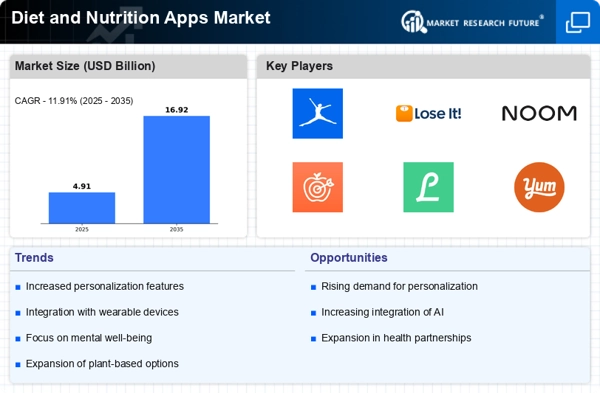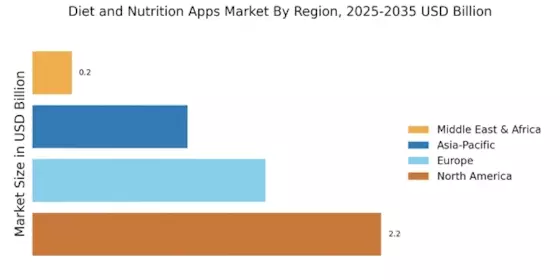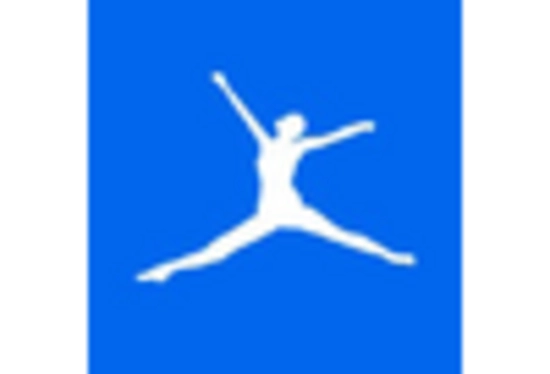Technological Advancements
The integration of advanced technologies into the Diet and Nutrition Apps Market is transforming how users interact with these applications. Features such as artificial intelligence, machine learning, and data analytics are enhancing the personalization of dietary recommendations. For instance, apps that utilize AI can analyze user data to provide tailored meal plans and nutritional advice, thereby improving user satisfaction and adherence to dietary goals. Furthermore, the incorporation of wearable technology allows for real-time tracking of health metrics, which can be synchronized with nutrition apps. This technological evolution not only attracts new users but also retains existing ones, as they benefit from a more interactive and engaging experience. As technology continues to evolve, the Diet and Nutrition Apps Market is poised for further innovation and expansion.
Rising Health Consciousness
The increasing awareness of health and wellness among consumers appears to be a primary driver for the Diet and Nutrition Apps Market. As individuals become more informed about the impact of diet on overall health, there is a growing demand for tools that assist in managing nutrition. Reports indicate that a significant percentage of the population is actively seeking ways to improve their dietary habits, which has led to a surge in the adoption of diet and nutrition applications. This trend is likely to continue, as more people recognize the importance of maintaining a balanced diet and the role that technology can play in achieving their health goals. Consequently, the Diet and Nutrition Apps Market is experiencing robust growth, with projections suggesting a substantial increase in user engagement and app downloads.
Increased Focus on Preventive Healthcare
The shift towards preventive healthcare is significantly influencing the Diet and Nutrition Apps Market. As healthcare systems worldwide emphasize the importance of preventing chronic diseases through lifestyle changes, nutrition apps are becoming essential tools for individuals seeking to manage their health proactively. Data suggests that a considerable portion of the population is utilizing these applications to monitor their dietary intake and make informed choices. This trend is likely to drive the growth of the market, as more users recognize the value of tracking their nutrition to prevent health issues. The Diet and Nutrition Apps Market is thus positioned to benefit from this paradigm shift, as consumers increasingly prioritize preventive measures over reactive healthcare.
Expansion of Dietary Preferences and Trends
The diversification of dietary preferences, including veganism, keto, and paleo diets, is driving growth in the Diet and Nutrition Apps Market. As consumers increasingly adopt specific dietary lifestyles, there is a corresponding demand for apps that cater to these preferences. Applications that provide tailored meal plans, recipes, and nutritional information aligned with various diets are becoming essential tools for users. Market Research Future suggest that the rise in specialized diets is influencing app development, leading to a broader range of offerings in the market. This trend not only attracts a diverse user base but also encourages innovation within the Diet and Nutrition Apps Market, as developers strive to meet the evolving needs of health-conscious consumers.
Growing Demand for Weight Management Solutions
The rising prevalence of obesity and related health issues is propelling the demand for weight management solutions within the Diet and Nutrition Apps Market. As individuals seek effective ways to lose weight and maintain a healthy lifestyle, nutrition apps that offer meal tracking, calorie counting, and exercise integration are gaining popularity. Market data indicates that a substantial number of users are turning to these applications for support in their weight loss journeys. This trend is expected to continue, as the societal focus on health and fitness intensifies. Consequently, the Diet and Nutrition Apps Market is likely to see an influx of new users seeking innovative solutions to achieve their weight management goals.


















Leave a Comment